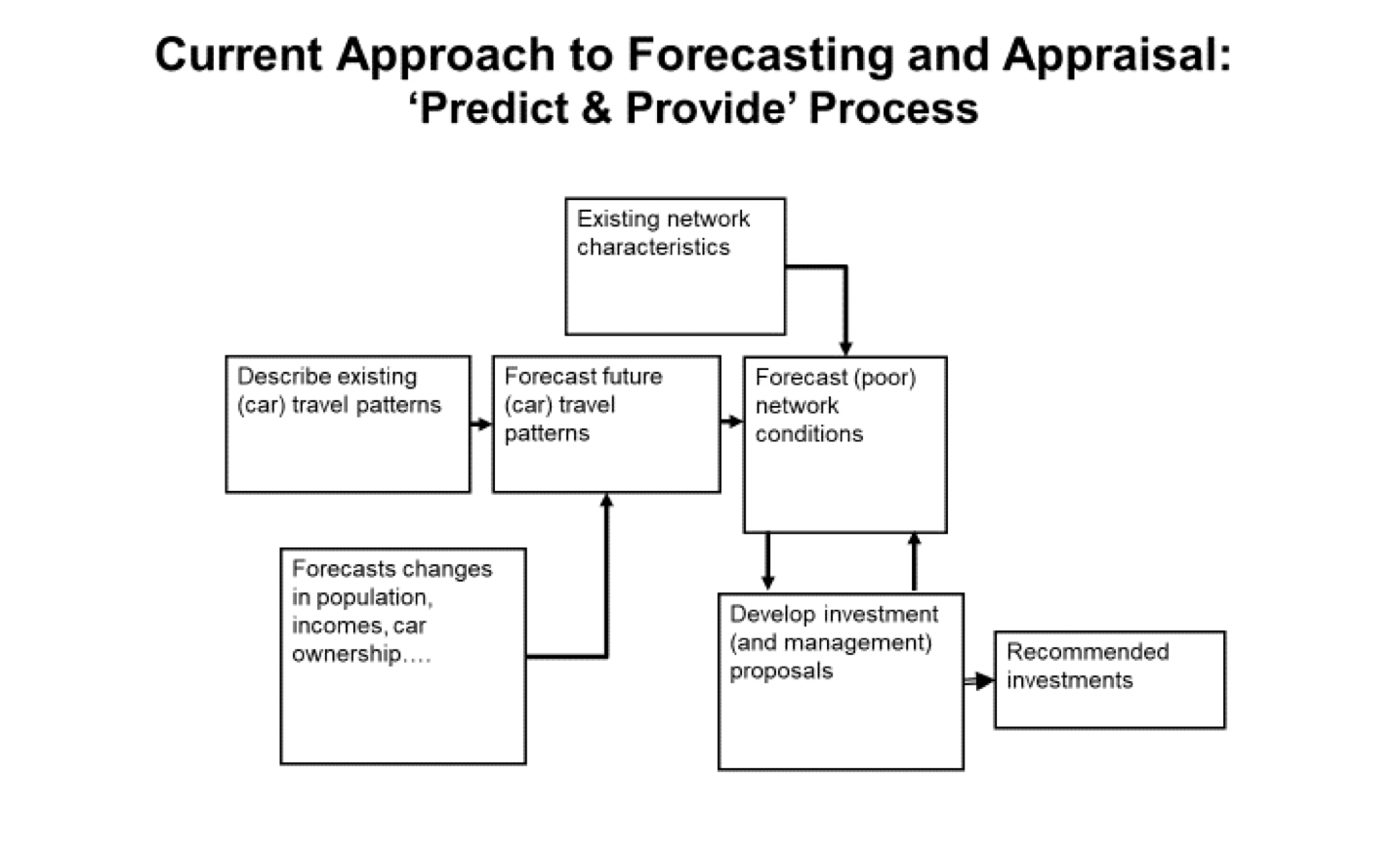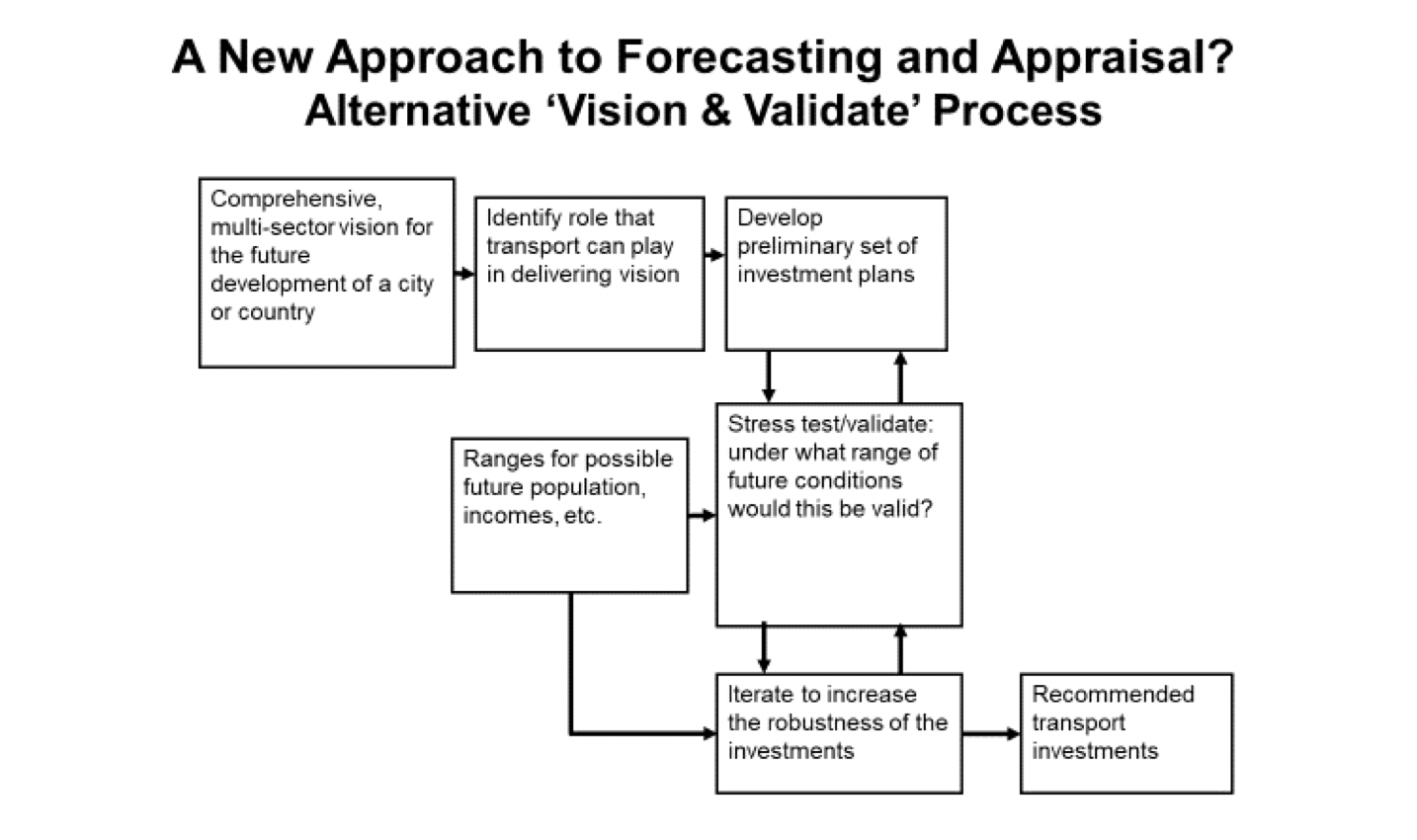TAPAS.network | 4 October 2023 | Commentary | Peter Jones
Visions require validation: new approaches for deciding and testing which policies will deliver

It has been widely accepted that better approaches are needed to developing and defining local transport strategies beyond the old ‘predict and provide’ thinking. But that will require new frameworks for creating the agreed visions, and ensuring that proposed policy measures are robust and effective, says . Here he explains the concept of ‘vision and validate’ and what it means for the way transport planning practitioners work.
TRANSPORT AUTHORITIES, at local, metropolitan and regional levels, have in recent years increasingly sought to set out their transport strategies and policies in the context of a broader and longer- term vision for their areas. These have been developed through a combination of political leadership – particularly in mayoral authorities – and extensive stakeholder engagement. Their scope usually extends well beyond the transport domain, to include considerations of economic development, well-being and quality of life.
This mirrors growing recognition at the national level, and reflected in enhanced appraisal methods, that transport has a much broader role to play in supporting policy goals than simply providing mobility, ranging from the health benefits of active travel, transport’s potential contribution to town centre regeneration, through to the levelling-up benefits of major transport investments. This aligns with the development of area-wide visions – that also recognise the need to tackle various negative transport impacts, ranging from carbon emissions and local air quality, to road safety and traffic congestion.
The development and articulation of a comprehensive, area-wide vision is a relatively new challenge for transport planners, but ‘visioning’ is a term increasingly being used at all levels of government, and is an approach that seems likely to be recommended in the forthcoming Local Transport Plan (LTP) guidance from the Department for Transport. It has also been endorsed by the International Transport Forum[1] and in various European Commission documents (e.g. SUMP Guidance, Step 5)[2].
The development of previous rounds of Local Transport Plans was mostly based on the now familiar, but increasingly questioned, ‘predict and provide’ approach to transport planning; a description believed to have been first coined by Susan Owens at the University of Cambridge, nearly 30 years ago[3]. Under this approach local authorities, like national transport agencies, would start their transport planning cycle by forecasting travel demands, to see to what extent these would impact on achieving agreed objectives and targets (such as reducing congestion or improving traffic safety); and then propose policy measures that would address these forecast shortfalls, including where appropriate, new road building to fill perceived gaps in the network, or to increase capacity.
This approach had the underlying aim of (passively) meeting and addressing the consequences of forecast travel demands, based on current and historical conditions, rather than (actively) shaping those patterns of demand through a suite of policy measures that best meet a set of desired high- level outcomes; and so tended to reinforce the status quo. In retrospect, ‘predict and provide’ was a misnomer, as either the forecasts were directly based on historical trend extrapolations, or obtained from behavioural choice models – but where the parameter values were derived from historical conditions. So, more correctly, this approach might have been characterised as ‘project and provide’.
However specifically named, the predict/project and provide thinking is now widely being replaced by a broader multi-modal, vision-led approach, in which transport is one key component. This requires a new set of planning tools and encourages a pro-active rather than a reactive approach to transport planning.
But there are also technical factors that are pushing authorities towards becoming vision-led, which relate to the growing recognition of the need to take into account uncertainty in future forecasting.
This process began some while back when modellers started incorporating sensitivity testing, to provide a range of estimates around a central forecast. More recently, this has been expanded to include the development of discrete scenarios, which vary the levels of the input variables that affect demand forecasts (for example, as set out in the recent DfT TAG Uncertainty Toolkit[4]). These provide a range of estimates of future transport demand, based on different contextual conditions, and have usefully demonstrated the range of uncertainty involved in forecasting. But, this process has also illustrated the limitations of adopting a predict/project and provide approach, since the severity of the issues that are raised (e.g. predicted future levels of carbon emissions) are likely to vary greatly from one scenario to another (e.g. from a scenario leading to a decline in traffic levels versus another leading to significant increases in traffic levels). So, the question inevitably arises: which of the scenario(s) should we be planning for? This strengthens the case for starting with an agreed long-term vision as the anchor point.
There is a further problem that authorities are facing, which relates to the practicality of achieving their adopted vision. While local visions are proliferating across the UK, in many cases there is a growing gap between political aspirations and practical realities. This problem is particularly evident in relation to the decarbonisation challenge – can credible and acceptable policy packages be developed that will deliver the carbon and traffic reductions that politicians are promising? I am aware of several local authority officers who have so far been unable to find practical ways to meet some of these more ambitious targets, especially those set for 2030. Visions, by their nature, are generally aspirational and designed to be inspirational, and may derive from convictions rather than evidence; but if they are not deliverable, this can lead to disillusionment and set back the achievement of the intended goals.
That is why authorities need to move beyond simply deciding on a vision for their area, to also ensuring that it is deliverable, on the ground. In the EU ‘CREATE’ project[5], we characterised this process as ‘vision and validate’. In other words, to sense check that a proposed vision is deliverable in practice (in terms of meeting quantified objectives and targets), on the basis of using appropriate analytical methods and business models, alongside fully taking into account public and political acceptability. Where it seems that it is not deliverable, then the vision – or at least the associated objectives and targets – will need to be modified.
Note the very different role that forecasting models play here: from traditionally being used in a linear way to predict futures as a starting point for determining policy priorities, to instead validating a set of policy measures that are capable of delivering the agreed vision, when specified in terms of a set of objectively measurable outcomes. The latter is more of a circular/recursive process, which may require several iterations. Others have characterised this shift as using models for ‘backcasting’ (i.e. starting with the intended outcomes and then working backwards to develop credible delivery paths), rather than for forecasting.
Here the role and nature of the scenarios also changes, from being the driver behind creating a range of demand forecasts, to being used to stress-test the feasibility of delivering the agreed vision through a proposed set of policy measures, that can be adapted as conditions change over time. This could also be thought of simplistically in nautical terms: a sailing ship’s destination is determined (the vision), but changing wind and wave conditions (identified through scenarios) will influence the precise route (pathway) and adjustments that are needed along the way. In the extreme case, the destination may need to be modified.


But, to achieve the ambitious targets that authorities are setting out as part of their vision development, we will need to be more imaginative in the measures that are included in policy packages, as the noted gap between rhetoric and reality illustrates. Einstein has been attributed as saying that “We cannot solve our problems with the same thinking we used when we created them”. So, we also need to pay greater attention to generating innovative policy options, and to framing problems in new ways.
Option generation (i.e. devising sets of policy measures that could collectively deliver intended outcomes) has not until recently been considered as a major stage of policy development. Treasury guidance has long encouraged scheme promoters to appraise a wide range of options for delivering their objectives; but this has been focused at a scheme-level, rather than considering a full package of measures that would deliver area-wide outcomes. And, in practice, scheme promotors often have ‘a solution looking for a problem’, and so develop a rather limited set of alternative options, in order to show the preferred solution in the best light.
Given both the scale of the challenges that we now face, and the commitment to take a more open-minded and inclusive approach to policy formulation, we really do need to develop sets of imaginative options that can contribute to meeting desired outcomes, both technically and in terms of feasibility and acceptability. But very little attention has been paid to the art and science of option generation; large sums of money are invested in data collection and analysis, and modelling and appraisal, but the recommended schemes/policy measures that emerge from this transport planning process are only as good as the options that are fed into it. There is a range of tools available to assist with a creative option generation process[6], but these have only had limited application within transport planning.
Several organisations have developed high-level menus of potential transport-related policy measures. One early example is the KonSULT tool, first developed in the early 2000s by the Institute for Transport Studies at the University of Leeds[7] which identifies policy measures that will assist a city in meeting its specific policy needs. More recent examples include the DfT Transport Decarbonisation Tool Kit[8] which provides advice to local authorities on actions they can take to reduce transport carbon emissions; and the list of measures in the EU SUMP Topic Guide on the Decarbonisation of Urban Mobility[9], grouped under the decarbonisation strategies of ‘Avoid-Shift- Improve’. There are also more specific option generation toolkits, such as one providing options for street design elements and road space reallocation[10].
However, as part of re-framing the debate, we need to look beyond mobility and transport in order to more comprehensively and effectively tackle our transport challenges, especially as much movement is a derived demand. In essence, this can be achieved by placing the emphasis on providing accessibility to people and places, goods and services, rather than simply providing physical mobility; this framing gives a broader canvass for public debate and for finding innovative solutions. In this context, the notion of ‘Triple Access Planning’ provides a useful framing tool, bringing together land use/built environment, transport systems and networks, and digital networks and services. One consequence of this is that transport planning professionals will need to engage more actively with a much broader range of stakeholders and, in particular to start dialogues with the major trip-generating sectors. Most obviously, to encourage them to consider their longer-term land use locational decisions in the context of contributing to meeting the agreed local vision. But also, in the short term, to support goals such as transport decarbonisation: by (i) reviewing the ways in which they deliver their goods and services to help reduce the amount of travel required, through localisation and digitisation of services; (ii) supporting modal shift and (iii) by electrifying, or otherwise switching from fossil fuels, their own fleets.[11]
Some practical short-term advances are being made in the health and social care sectors, in particular encouraged by the NHS nationally having adopted ‘Scope 3-Plus’ carbon accounting; this has identified that 14% of all the sector’s carbon emissions come from transport (freight and passenger)[12]. Most importantly, the organisation has accepted responsibility for eliminating these emissions, over time. In the case of Greater Manchester, this has led to a close collaboration with the transport authority TfGM, and the introduction of health care policies that are reducing the amount of travel, and are encouraging remaining trips to be made by sustainable modes, where possible[13].
Other public sector bodies are also mapping their carbon emissions, including those arising from transport, as are many larger private sector organisations. In April 2021, for example, the CBI published a report recommending that its members at least take responsibility for the transport carbon emissions arising from employee business travel and commuting trips[14]. Such initiatives result in shared carbon objectives across the public and private sectors, and provide a unique opportunity for closer, cross-sector collaboration with key trip generating sectors. Once established, these could be built upon to extend well beyond consideration of carbon emissions, to support other aspects of local vision delivery.
The issues raised here can only touch on some of the changes in approach that are needed in order to meet the major challenges now being faced by the transport planning profession, in helping to deliver the visions that are being developed by local transport authorities, and to validate their suitability and acceptability.
The challenges are to be found in the areas of both vision development and vision delivery. There are particular implications for the ways in which engagement is undertaken, involving a growing range of stakeholders and the wider public, ranging in purpose from the development of the vision itself, through to the co-design of local street schemes. There are also major governance re-sets that need to be considered, particularly within administration, regulation and financing – all crucial for delivery. And, at an analytical level, there are implications for the methods and models we use to explore and appraise the world. For example, through generating new solutions by switching from a trip-based ‘mobility’ framing, to an activity-based ‘accessibility’ framing; and by embracing scenarios as a stress-testing tool.
A growing number of local authorities are declaring a climate emergency, and the Department for Transport now requires local authorities to produce a Transport Decarbonisation Plan. This gives an added urgency to addressing the issues raised in this article. Put simply, we need to identify both where we are going - and how we are going to get there.
References and Links
-
Broadening appraisal: Capturing the full impacts of transport investments International Transport Forum Septemtber 2022 https://www.itf-oecd.org/broadening-transport-appraisal
-
https://www.eltis.org/sites/default/files/sump_guidelines_2019_interactive_document_1.pdf
-
From ‘predict and provide’ to ‘predict and prevent’?: pricing and planning in transport policy. Susan Owens University of Cambridge. Transport Policy, Vol. 2, No. I, pp. 43-49, 1995.
-
TAG Uncertainty Toolkit. Transport Analysis Guidance, May 2023, DfT.
-
‘Congestion Reduction in Europe: Advancing Transport Efficiency’. See https://create-mobility.eu/PUBLICATIONS/DELIVERABLES/CREATE_D75-AcityIntroductiontoCREATE.pdf
-
“Innovative Approaches to Option Generation”. Peter Jones, Charlotte Kelly, Anthony May and Steve Cinderby. European Journal of Transport and Infrastructure Research, 9(3), pp 237 – 258, 2009.
-
(https://www.gov.uk/government/collections/transport-decarbonisation-local-authority-toolkit)
-
(https://www.eltis.org/sites/default/files/sump_topic_guide_decarbonisation.pdf)
-
Delivering a ‘Net Zero’ National Health Service. October 2020.
-
(https://sump-plus.eu/fileadmin/user_upload/Resources/Reports_and_publications/SUMP- PLUS-PB2-web.pdf)
-
Greener Miles: delivering on a net-zero vision for commuting.
Peter Jones is professor of transport and sustainable development in the Centre for Transport Studies at UCL. Previously he was Director of the Transport Studies Group at the University of Westminster, and Deputy Director of the Transport Studies Unit at Oxford University.
This article was first published in LTT magazine, LTT877, 4 October 2023.
You are currently viewing this page as TAPAS Taster user.
To read and make comments on this article you need to register for free as TAPAS Select user and log in.

Log in